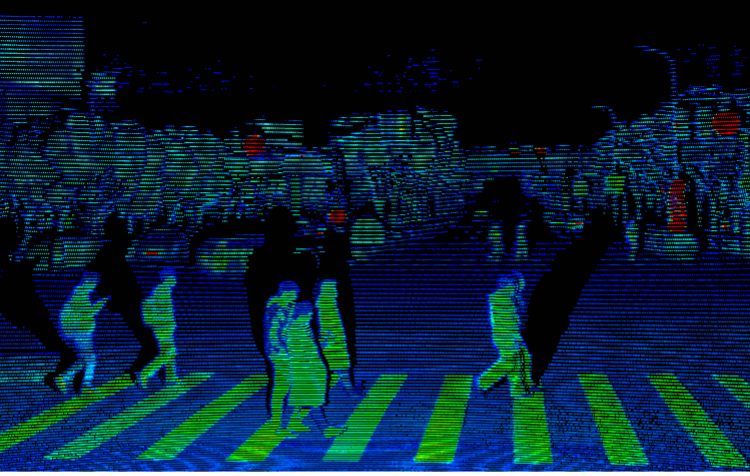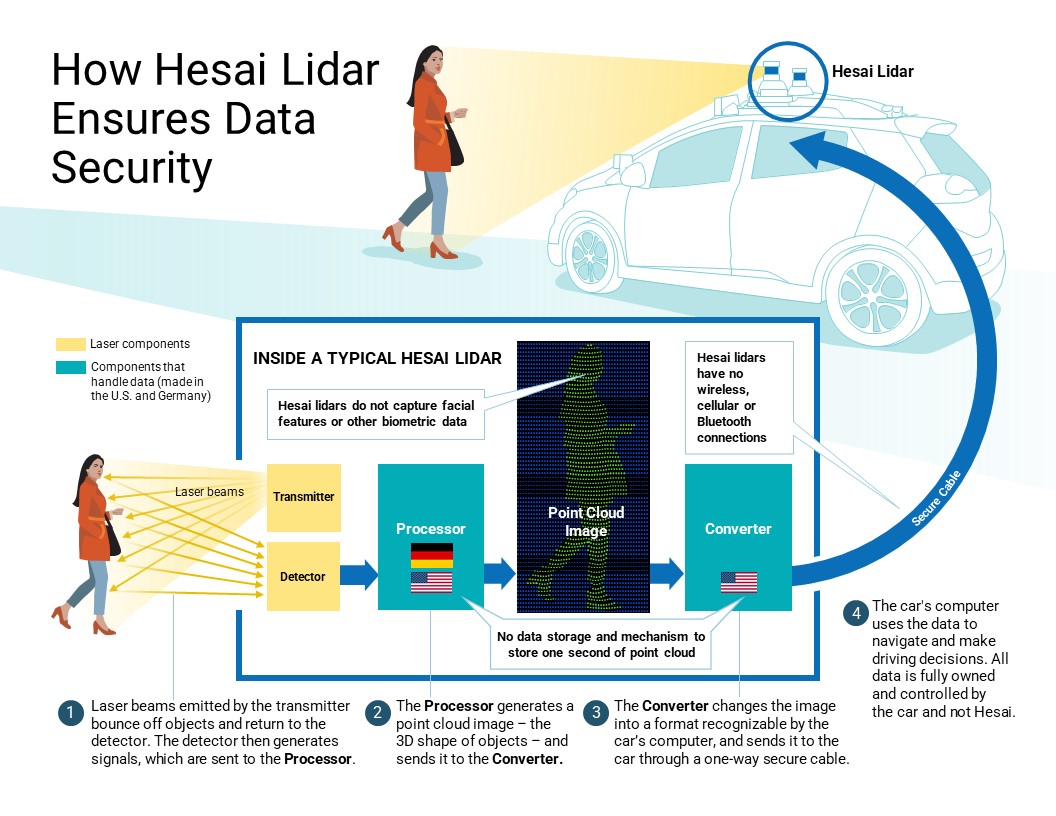Hesai lidars do not keep or access the image data they generate
By David Li
The mission of Hesai is to make vehicles safer and to save lives by enabling 3D sensing capabilities for intelligent driving systems. We design and build high-quality lidars that use low-energy lasers to scan the environment around a vehicle and send the results securely to a vehicle’s computer. The computer uses the data to make smart, safe driving decisions. Hesai lidars do not keep any of the scanned data. They cannot wirelessly transmit data and the data cannot flow backward into our lidars.
Hesai lidars will improve road safety and data security; we believe they should be on every car. But widespread adoption of lidar technology would not have happened without trust – trust from drivers, automakers and policymakers. Hesai wins this trust, in large measure, by ensuring the highest level of data security. Data security is hard-wired into Hesai lidars and into our company’s core values.
Lidars, an acronym for “light detection and ranging,” are the eyes of all intelligent robots, from autonomous cars to autonomous guided vehicles in factories. The lasers in lidars create a 3D view of a vehicle’s surroundings, including other cars, buildings, traffic signs and pedestrians, as shown below.

When a lidar scans people, it sees only their size, shape, distance and motion. Unlike cameras on vehicles, lidars can see in poor weather, low and no light. Also, unlike cameras, lidars do not capture human facial features or any other identifying biometric data. In other words, lidars are the best option for saving lives while safeguarding privacy.
Lidars are to vehicles what our eyes are to our brains: the lidar “sees” and the car’s computer “thinks.” Lidars see a vehicle’s surroundings and send information to the car through a one-way secure cable – nonstop – just like water through a pipe. All data is stored in the onboard computer and fully owned by the vehicle, not the lidar nor the lidar manufacturer. Thus, Hesai has no access to it.
But can Hesai lidars leak data? Or can data somehow be extracted from them? No. And that’s because of the way they are designed and manufactured.
First, the company’s commitment to data security begins even before a lidar is assembled – it starts in the product design phase. Hesai has created a secure supply chain. Components inside Hesai lidars are made by trusted, top-tier global suppliers that practice the highest levels of data security. We have an exceptionally stringent supplier selection process. The key components in our automotive products with access to data come from American and European suppliers.
Second, Hesai lidars do not store and cannot wirelessly transmit data. There is no storage and mechanism to store even one second of the image they see. Additionally, Hesai lidars have no wireless transmission capabilities. They contain no cellular, wi-fi or Bluetooth, so data cannot wirelessly leak from Hesai lidars and there is no way for anyone to wirelessly extract data. There is no so-called backdoor to access the information that Hesai lidars generate.
Less than a decade since our founding, Hesai has become the automotive lidar industry leader by designing and mass-producing high-performing lidars that meet the highest automotive industry standards. We are proud of that accomplishment, but it would not have happened if our customers did not believe in or trust our commitment to data security. We are completely transparent with our customers about how our lidars work and how we ensure data security. Our customers, including global automakers and robotaxi companies, have complete control over the data our lidars generate. Once the data leaves our lidars, it is in their hands to keep.
But don’t just take our word for it. Earlier this year, Hesai become the first lidar company to obtain the ISO/SAE 21434 automotive cybersecurity management certification from TÜV Rheinland, an international authoritative third-party testing and certification institution.
Also this year, Hesai passed the highest assessment level of TISAX, the Trusted Information Security Assessment Exchange, achieving the highest standard in the European automotive industry. TÜV SÜD, a world-renowned TISAX assessment provider, audited not only Hesai’s lidars to determine if they ensure data security, but also examined Hesai’s corporate operations, from top to bottom, including information processing, work equipment, IT systems and even contractors.
The third-party assessments of Hesai reinforced what Wall Street knew – that we are as open about our corporate structure as we are about the way we secure data. Hesai began as a privately owned company controlled by our three founders and capitalized by several international investors, including those in the U.S., Europe, and China. Our Chinese investors are privately owned companies. In February, Hesai listed on the NASDAQ (“HSAI”), underwritten by Goldman Sachs and Morgan Stanley, which closely examined Hesai’s books and operations and were satisfied with the company’s ownership independence and commitment to transparency. The same is true of Hesai’s American customers, which include AI giant NVIDIA, and autonomous vehicle technology companies Aurora, Nuro and Amazon Zoox.
It’s true, we make our lidars to protect data. But even more so, we make our lidars to protect lives. They are manufactured and sold for civilian, commercial use only. They help cars make more intelligent driving decisions that prevent collisions with other cars, people, pets and property. Hesai lidars help to save lives and make vehicle transportation safer worldwide.
David Li is CEO and co-founder of Hesai Technology and a University of Illinois Urbana-Champaign graduate.
Contact:
Executives-Edge.com
Editor@executives-edge.com








